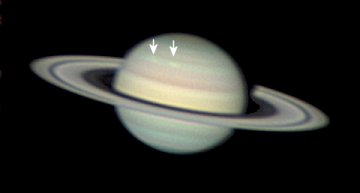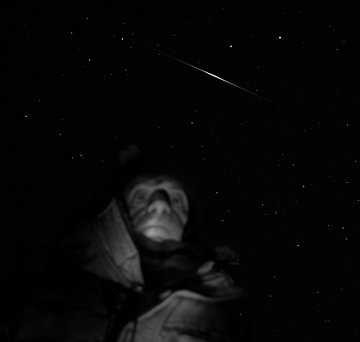| MOTHER'S DAY: Give your mom a truly heavenly gift on May 11th--a subscription to Space Weather PHONE! | | | CME UPDATE: Geomagnetic activity remains low. A coronal mass ejection hurled into space by the April 26th "no-sunspot" solar flare has either missed Earth or its impact was too weak to register on solar wind sensors in Earth orbit. Auroras tonight appear unlikely. STORMS ON SATURN: Amateur astronomers photographing Saturn this week have found something unexpected. "I was taking routine images of Saturn this evening, hoping to see some interesting features," says Ian Sharp of Ham, UK. "I was thrilled to see I had captured two storms" denoted by arrows in the picture below: 
They're little more than smudges in this view through a backyard telescope, but each one is a continent-sized tempest with wind speeds as high as 1000 mph. Saturn's storms are white because their cloudtops are filled with ammonia ice crystals--think of the ice halos!--and they sometimes crackle with powerful lightning that radio receivers onboard the Cassini spacecraft have recorded on many occasions: listen. These storms appear to be intensifying and are now easy targets for backyard telescopes equipped with CCD cameras. Monitoring is encouraged: sky map. more images: from Günther Strauch of Borken, NRW, Germany; from Roman Breisch of Erdweg, Bavaria, Germany; IRIDIUM FLARES, ALL NIGHT LONG: Anyone who's ever seen an Iridium satellite flaring in the night sky knows what it must be like to witness a supernova. Sudden. Breath-taking. Unforgettable. At the South Pole, the unforgettable happens 160 times a day. NSF research engineer J. Dana Hrubes sends this report from the Amundsen-Scott South Pole Station where all six orbital planes of the polar-orbiting Iridium satellites cross: "The sun has set here for 6 months and we get Iridium flares every 9 minutes and 8 seconds for 4-5 days at a time." Indeed, such a "flare session" is underway now. 
This April 28th self-portrait shows Hrubes with a flare in the background near the Southern Cross. The brilliant flash of light occurred when sunlight glinted off one of the satellite's flat surfaces. "I took this picture and three others using my Canon Rebel XTI 400D," says Hrubes. "The brightest magnitude -8 flares occur every 9 min for an entire day! We routinely use the Iridium satellites for communication from the Pole."
| 
